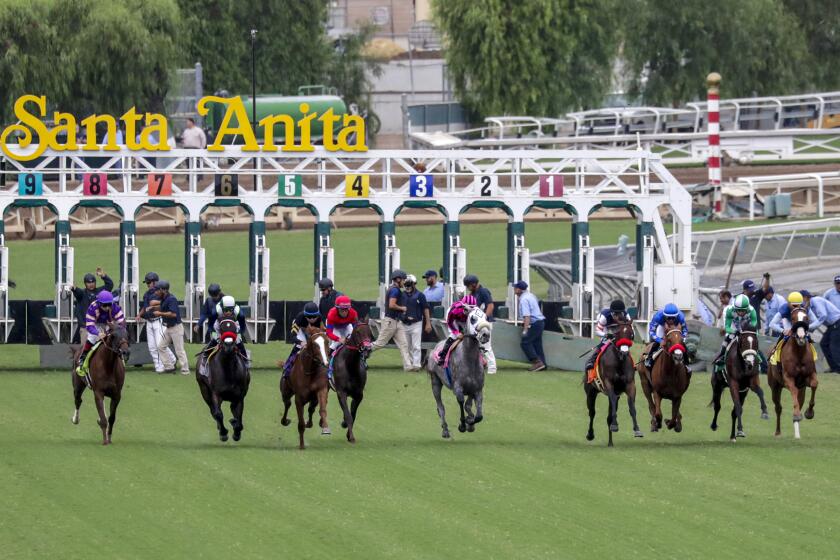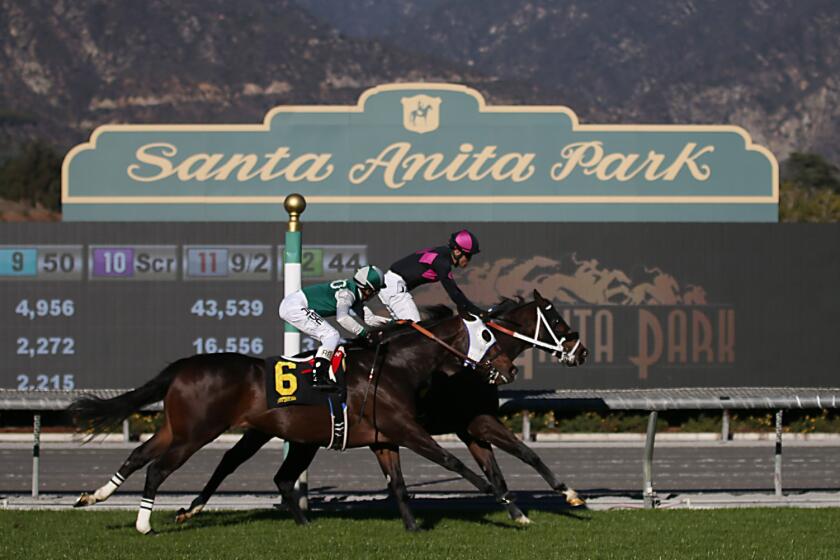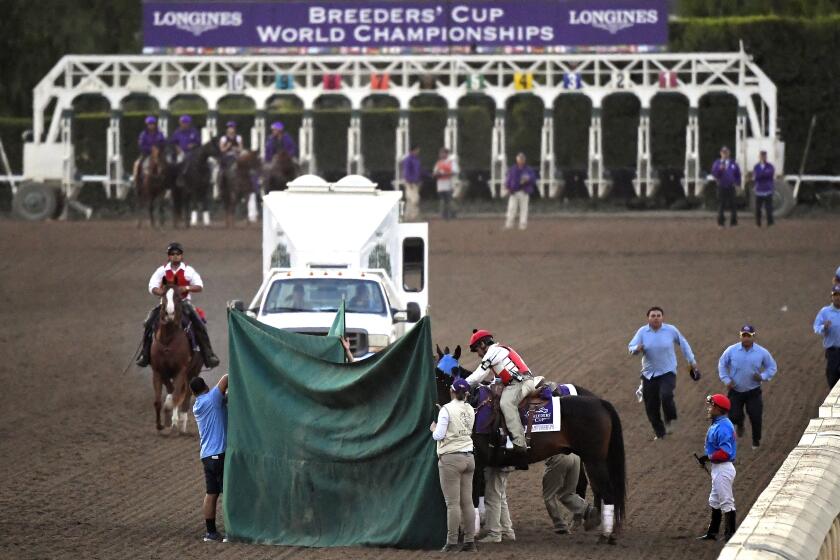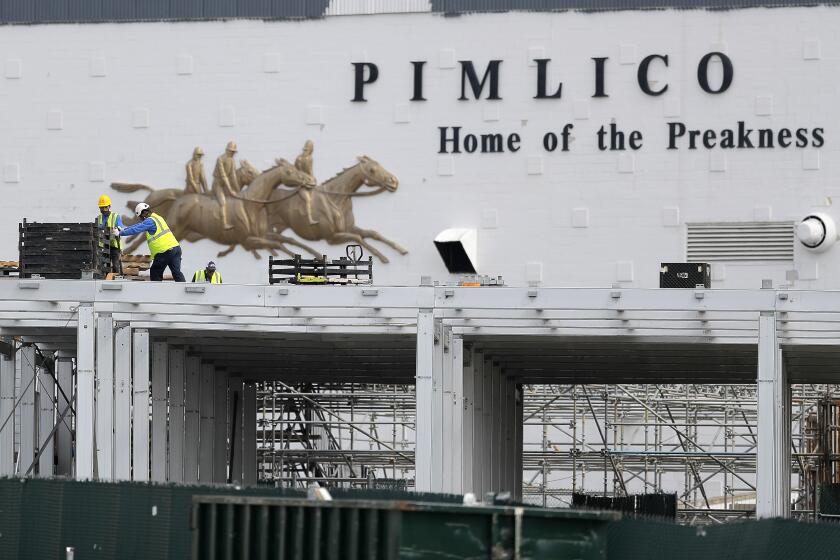Santa Anita is using music acts, including Shaboozey, in the hopes of attracting new fans
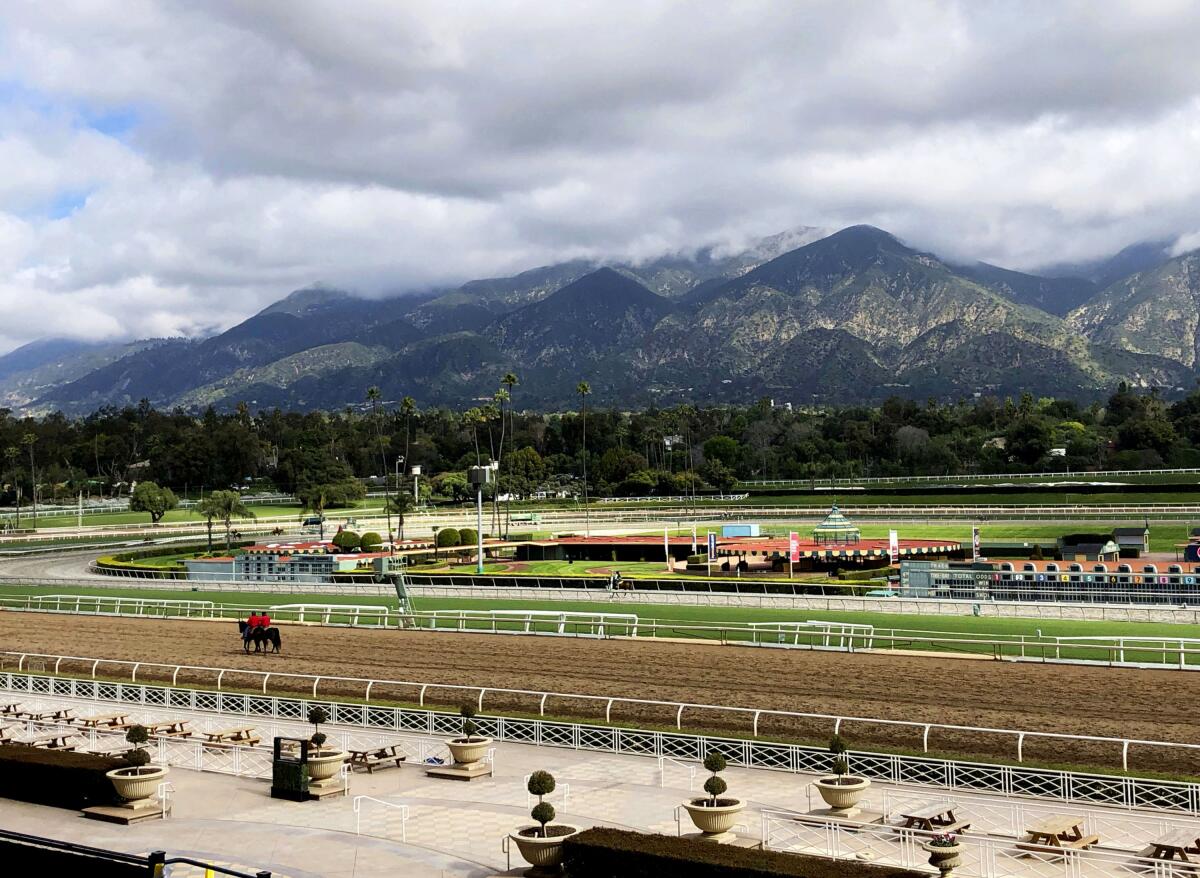
- Share via
The California Horse Racing Board met last week in Sacramento to decide the immediate future of horse racing in the northern part of the state. There was tension, confrontation and a sense of desperation from all the proponents in the room looking for a lifeline to run a short three-month meeting in Pleasanton to show that they can do it.
The meeting had everything but power. No, not the kind of power that politicians wield with impunity. Actual honest-to-goodness electrical power, the stuff of Edison and Tesla that drives microphones, lighting and the internet.
It might have been the first time this sort of thing has happened in more than 20 years but the difficulties were emblematic of the current state of California horse racing, a sport that is closer to circling the drain than stopping the bleeding.
So, how does California’s largest race track deal with the current state of the business? Why throw a party, of course.
CHRB delays decision on Northern California racing until March. A case is made that for Southern California racing to survive, the north must go.
On Saturday, Santa Anita is hosting the California Crown, a first-year event that is supposed to entice people to experience horse racing by offering healthy sides of musical entertainment, an elevated food experience and the belief the sport can provide more than hoof beats and tote boards.
Some see this as a new version of the apocryphal story of Nero fiddling while Rome burns. Others see it as the Stronach Group, owner of Santa Anita, believing so much in the sport that this type of event will energize the populace and bring much-needed new fans to the sport.
“I know they want this to be a day that mirrors the Pegasus at Gulfstream Park in Florida,” said Bill Nader, president and chief executive of the Thoroughbred Owners of California. “So, we’ll see how it goes. It’s a very competitive landscape in Southern California this time of year with USC and UCLA football both being at home, and possibly before sellout crowds. [TSG] is putting its money up and taking its best shot.
“Regardless, if someone says it’s the right use of money, it’s their company, it’s their race track, it’s their call. But we’ll get behind it.”
Aidan Butler, Santa Anita’s new racing boss, met with the Los Angeles Times to talk about the challenges ahead after 31 horse deaths at the facility.
The day starts at 12:30 p.m. with the first of 10 races. The big races start about 3:30 p.m. with the $750,000 John Henry Turf Championship going 1 ¼ miles, followed by the $750,000 Eddie D Stakes for horses going about 6 ½ furlongs on the downhill turf course.
The big event was supposed to be the $1-million California Crown at 4:30 p.m., with a less than hoped for group of six horses going 1 1/8 miles on the dirt. The race was formerly known as the Awesome Again Stakes, when it paid only $300,000.
The California Crown race is part of a bonus program with a $5-million bonus to any horse that won the Preakness Stakes, California Crown and Pegasus. However, that became meaningless when Preakness winner Seize the Grey elected to skip the California Crown and instead run in the Pennsylvania Derby last week, which he won. There are also bonuses tied to the turf races.
The music will start after the first race is over with Siobhan followed by Amika (1:11 p.m.), the McLarens (1:45 p.m.), Elan Bia (3:42 p.m.), Shaboozey (4:13 p.m.), Zack Bia (5:21 p.m.), Lil Yachty and Zack Bia (5:30 p.m.), Frank Walker (5:51 p.m.) and Gryffin (6:40 p.m.)
Shaboozey is probably the hottest name right now based on a few hits on the country music charts. His set, like most, will last about 20 minutes. The stage is trackside, in the Delila VIP area, just past the finish line. General admission, which was free Friday, is $27.30 on Saturday. General parking is free.
The size of a race horse and its natural instincts make it nearly impossible to survive serious injuries at the track, but many are trying to improve the odds.
The Delilah trackside box seats, the highest ticket prices, cost $1,372.50 a seat.
“Some concerts work, some concerts don’t work,” said Robert Hartman, who worked in marketing at Santa Anita before becoming general manager at Golden Gate Fields. He is currently the director of the Race Track Industry Program at the University of Arizona.
“We had two types of musical groups,” Hartman said. “One was groups that were just getting started. They were hot but only had maybe one hit. The hope was by the time you booked them they had two, three, four, five hits.
“Or they were the opposite, they had a brand name but their brand has faded. One that comes to mind is Frankie Valli. He had the brand and people still wanted to see him because he was Frankie Valli. The Beach Boys would be another example.”
Hartman remembers when No Doubt, fronted by Gwen Stefani, played at Santa Anita. “We probably had 25,000 to see No Doubt,” Hartman said. “They got more and more popular between the time we booked them and the time they performed. We almost had to shut the admissions gates. And they were relatively inexpensive.”
It was the biggest race before the Kentucky Derby, and undefeated colt Nyquist was leading as he headed into the homestretch at the Florida Derby.
The real goal of these types of promotions is to collect data about those who are new to racing so they can be the target of direct marketing.
While Hartman believes it’s best to intersperse the music between races, it’s not the only way to do things.
“Del Mar’s now discontinued concerts were apparently very successful, especially their innovation of having the concerts after the races,” said Alan Balch a longtime Santa Anita marketing and public relations executive who is the executive director of the California Thoroughbred Trainers.
“It enabled concertgoers to come to the races earlier, at the regular low track admission price, but then have to pay a much higher admission to come to the concert alone. To any regular racing fan attending those days, it was a win-win — large numbers of new fans being introduced to the races, with the attendant buzz in the crowd. The after-race concerts did not disturb any racing activities. This is the very definition of successful market development, provided the concert cost-benefit analysis indicated break-even or better.”
Aidan Butler is the chief executive over TSG’s ever-shrinking racing empire. The company closed Golden Gate Fields this year and gave Pimlico Race Course in Baltimore to the state so it didn’t have to pay for a massive rebuild of the ancient facility.
The Stronach Group will divest itself of Pimlico Race Course. It’s the second track TSG has exited from, leaving California racing in a state of nervousness.
“The criticism of California is that no one markets anymore and we take that as a fair criticism,” Butler said. “How do you get visibility for a racetrack that is in a very highly populated area that is Hollywood? I’m just trying to get visibility to a newer audience. And you can’t do that with just horse racing.”
California racing has been in decline for several years. The state has some of the lowest purses compared with the racing circuits in Kentucky and New York. The difference is those states get supplemental income from casino gambling, something California does not. Kentucky purses have reached ridiculously high levels since the introduction of Historical Horse Racing, marketed as a game of skill using old horse races as content but is really little more than a slot machine.
Purses are paid through a percentage of money bet on the races and managed by the TOC. If there is not enough revenue by virtue of reduced mutuel handle, the TOC enters what’s counterintuitively known as an overpayment. The shortfall is paid by the track with the fantastical notion that it will one day be paid back.
The closure of Golden Gate Fields is just one problem California horse racing faces. Non-competitive purses and a sinking foal crop paint a tough picture.
During the six-month winter-spring meeting at Santa Anita, there was a shortfall of $5 million, which Santa Anita is carrying. At Del Mar, the track picked up $1 million in purses.
TSG is picking up the tab for Saturday’s racing, which amounts to about $3.1 million.
“Some ask why don’t they take that money and put it into overnight [daily] purses or to pay down the overpayment, but in the end, it’s their money, their race track and if they elect to go for the big bang marketing effort then who are we to object,” Nader said.
“We have to respect their strategic investment if they believe that this is a better approach and it’s going to help. Either effort would benefit horse owners but … we have to respect their position. I could make an argument for either side. If they were to come and offer that money for overnights, I’d be in favor of that too.”
Hartman points out that even if Saturday is a huge success, you need a strategy beyond that one day.
“On the negative side, we would get people on a big day like that and they had a good time and they come back on a Thursday and the experience wasn’t quite as energetic,” Hartman said. “It was always my concern when their second visit didn’t live up to the excitement of the first visit with live music. Would that then turn them off?”
Balch says all tracks need to look beyond the next big weekend.
“Any marketing, advertising, sales promotion efforts must be part of a plan which enables measuring effectiveness,” Balch said. “All ‘proper’ marketing is for profit, either short or long-term, and must be subject to analysis of cost vs. benefit.”
If Saturday’s card is a success as an experience — it’s highly unlikely it will be a financial success — Butler understands the tightrope that must be walked between regular and new race-goers.
“We really do give a lot of thought into customers that are here day in and day out,” Butler said. “The elevation of the experience is to attract new customers. But we still want to show the love to customers who come day in and day out. And you’ve got the ADW [advance deposit wagering] crowd and the people who bet from home. I’m hoping from a betting standpoint there will be a great card to wager on.”
It will take time to assess if this grand experiment will make a difference or if one day Shaboozey will be the answer to a trivia question as to who played a significant role in saving California racing.
More to Read
Go beyond the scoreboard
Get the latest on L.A.'s teams in the daily Sports Report newsletter.
You may occasionally receive promotional content from the Los Angeles Times.
